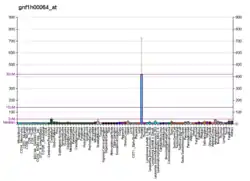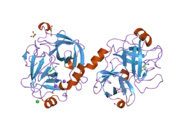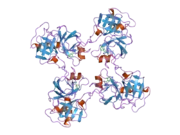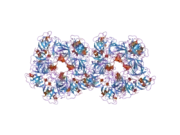| KLK4 | |||||||||||||||||||||||||||||||||||||||||||||||||||
|---|---|---|---|---|---|---|---|---|---|---|---|---|---|---|---|---|---|---|---|---|---|---|---|---|---|---|---|---|---|---|---|---|---|---|---|---|---|---|---|---|---|---|---|---|---|---|---|---|---|---|---|
 | |||||||||||||||||||||||||||||||||||||||||||||||||||
| |||||||||||||||||||||||||||||||||||||||||||||||||||
| Identifiers | |||||||||||||||||||||||||||||||||||||||||||||||||||
| Aliases | KLK4, AI2A1, ARM1, EMSP, EMSP1, KLK-L1, PRSS17, PSTS, kallikrein, kallikrein related peptidase 4 | ||||||||||||||||||||||||||||||||||||||||||||||||||
| External IDs | OMIM: 603767 MGI: 1861379 HomoloGene: 55856 GeneCards: KLK4 | ||||||||||||||||||||||||||||||||||||||||||||||||||
| |||||||||||||||||||||||||||||||||||||||||||||||||||
| |||||||||||||||||||||||||||||||||||||||||||||||||||
| |||||||||||||||||||||||||||||||||||||||||||||||||||
| |||||||||||||||||||||||||||||||||||||||||||||||||||
| |||||||||||||||||||||||||||||||||||||||||||||||||||
| Wikidata | |||||||||||||||||||||||||||||||||||||||||||||||||||
| |||||||||||||||||||||||||||||||||||||||||||||||||||
Kallikrein-related peptidase 4 is a protein which in humans is encoded by the KLK4 gene.[5][6][7]
Kallikreins are a subgroup of serine proteases having diverse physiological functions.[8] Growing evidence suggests that many kallikreins are implicated in carcinogenesis and some have potential as novel cancer and other disease biomarkers. In particular, they may serve as biomarkers for both prostate cancer and breast cancer.
This gene is one of the fifteen kallikrein subfamily members located in a cluster on chromosome 19. In some tissues its expression is hormonally regulated. The expression pattern of a similar mouse protein in murine developing teeth supports a role for the protein in the degradation of enamel proteins.[9] Alternate splice variants for this gene have been described, but their biological validity has not been determined.[10]
References
- 1 2 3 GRCh38: Ensembl release 89: ENSG00000167749 - Ensembl, May 2017
- 1 2 3 GRCm38: Ensembl release 89: ENSMUSG00000006948 - Ensembl, May 2017
- ↑ "Human PubMed Reference:". National Center for Biotechnology Information, U.S. National Library of Medicine.
- ↑ "Mouse PubMed Reference:". National Center for Biotechnology Information, U.S. National Library of Medicine.
- ↑ Simmer JP, Fukae M, Tanabe T, Yamakoshi Y, Uchida T, Xue J, Margolis HC, Shimizu M, DeHart BC, Hu CC, Bartlett JD (February 1998). "Purification, characterization, and cloning of enamel matrix serine proteinase 1". Journal of Dental Research. 77 (2): 377–86. doi:10.1177/00220345980770020601. PMID 9465170. S2CID 21816663. Archived from the original on 2008-08-21. Retrieved 2008-10-20.
- ↑ Nelson PS, Gan L, Ferguson C, Moss P, Gelinas R, Hood L, Wang K (March 1999). "Molecular cloning and characterization of prostase, an androgen-regulated serine protease with prostate-restricted expression". Proceedings of the National Academy of Sciences of the United States of America. 96 (6): 3114–9. Bibcode:1999PNAS...96.3114N. doi:10.1073/pnas.96.6.3114. PMC 15904. PMID 10077646.
- ↑ Stephenson SA, Verity K, Ashworth LK, Clements JA (August 1999). "Localization of a new prostate-specific antigen-related serine protease gene, KLK4, is evidence for an expanded human kallikrein gene family cluster on chromosome 19q13.3-13.4". The Journal of Biological Chemistry. 274 (33): 23210–4. doi:10.1074/jbc.274.33.23210. PMID 10438493.
- ↑ Lundwall A, Band V, Blaber M, Clements JA, Courty Y, Diamandis EP, Fritz H, Lilja H, Malm J, Maltais LJ, Olsson AY, Petraki C, Scorilas A, Sotiropoulou G, Stenman UH, Stephan C, Talieri M, Yousef GM (June 2006). "A comprehensive nomenclature for serine proteases with homology to tissue kallikreins". Biological Chemistry. 387 (6): 637–41. doi:10.1515/BC.2006.082. PMID 16800724. S2CID 436200.
- ↑ Simmer JP, Fukae M, Tanabe T, Yamakoshi Y, Uchida T, Xue J, Margolis HC, Shimizu M, DeHart BC, Hu CC, Bartlett JD (June 2000). "Characterization of the mouse and human PRSS17 genes, their relationship to other serine proteases, and the expression of PRSS17 in developing mouse incisors". Gene. 251 (1): 1–8. doi:10.1016/S0378-1119(00)00203-1. PMID 10863090. Archived from the original on 2008-08-21. Retrieved 2008-10-20.
- ↑ "Entrez Gene: KLK4 kallikrein-related peptidase 4".
Further reading
- Clements J, Hooper J, Dong Y, Harvey T (2001). "The expanded human kallikrein (KLK) gene family: genomic organisation, tissue-specific expression and potential functions" (PDF). Biol. Chem. 382 (1): 5–14. doi:10.1515/BC.2001.002. PMID 11258672. S2CID 5864448.
- Simmer JP, Fukae M, Tanabe T, et al. (1998). "Purification, characterization, and cloning of enamel matrix serine proteinase 1". J. Dent. Res. 77 (2): 377–86. doi:10.1177/00220345980770020601. PMID 9465170. S2CID 21816663.
- Nelson PS, Gan L, Ferguson C, et al. (1999). "Molecular cloning and characterization of prostase, an androgen-regulated serine protease with prostate-restricted expression". Proc. Natl. Acad. Sci. U.S.A. 96 (6): 3114–9. Bibcode:1999PNAS...96.3114N. doi:10.1073/pnas.96.6.3114. PMC 15904. PMID 10077646.
- Stephenson SA, Verity K, Ashworth LK, Clements JA (1999). "Localization of a new prostate-specific antigen-related serine protease gene, KLK4, is evidence for an expanded human kallikrein gene family cluster on chromosome 19q13.3-13.4". J. Biol. Chem. 274 (33): 23210–4. doi:10.1074/jbc.274.33.23210. PMID 10438493.
- Yousef GM, Obiezu CV, Luo LY, et al. (1999). "Prostase/KLK-L1 is a new member of the human kallikrein gene family, is expressed in prostate and breast tissues, and is hormonally regulated". Cancer Res. 59 (17): 4252–6. PMID 10485467.
- DuPont BR, Hu CC, Reveles X, Simmer JP (2000). "Assignment of serine protease 17 (PRSS17) to human chromosome bands 19q13.3→q13.4 by in situ hybridization". Cytogenet. Cell Genet. 86 (3–4): 212–3. doi:10.1159/000015340. PMID 10575207. S2CID 42446073.
- Hu JC, Zhang C, Sun X, et al. (2000). "Characterization of the mouse and human PRSS17 genes, their relationship to other serine proteases, and the expression of PRSS17 in developing mouse incisors". Gene. 251 (1): 1–8. doi:10.1016/S0378-1119(00)00203-1. PMID 10863090.
- Gan L, Lee I, Smith R, et al. (2001). "Sequencing and expression analysis of the serine protease gene cluster located in chromosome 19q13 region". Gene. 257 (1): 119–30. doi:10.1016/S0378-1119(00)00382-6. PMID 11054574.
- Obiezu CV, Diamandis EP (2001). "An alternatively spliced variant of KLK4 expressed in prostatic tissue". Clin. Biochem. 33 (7): 599–600. doi:10.1016/S0009-9120(00)00178-8. PMID 11124349.
- Takayama TK, Carter CA, Deng T (2001). "Activation of prostate-specific antigen precursor (pro-PSA) by prostin, a novel human prostatic serine protease identified by degenerate PCR". Biochemistry. 40 (6): 1679–87. doi:10.1021/bi002129r. PMID 11327827.
- Korkmaz KS, Korkmaz CG, Pretlow TG, Saatcioglu F (2001). "Distinctly different gene structure of KLK4/KLK-L1/prostase/ARM1 compared with other members of the kallikrein family: intracellular localization, alternative cDNA forms, and Regulation by multiple hormones". DNA Cell Biol. 20 (7): 435–45. doi:10.1089/104454901750361497. PMID 11506707.
- Takayama TK, McMullen BA, Nelson PS, et al. (2002). "Characterization of hK4 (prostase), a prostate-specific serine protease: activation of the precursor of prostate specific antigen (pro-PSA) and single-chain urokinase-type plasminogen activator and degradation of prostatic acid phosphatase". Biochemistry. 40 (50): 15341–8. doi:10.1021/bi015775e. PMID 11735417.
- Hural JA, Friedman RS, McNabb A, et al. (2002). "Identification of naturally processed CD4 T cell epitopes from the prostate-specific antigen kallikrein 4 using peptide-based in vitro stimulation". J. Immunol. 169 (1): 557–65. doi:10.4049/jimmunol.169.1.557. PMID 12077288.
- Strausberg RL, Feingold EA, Grouse LH, et al. (2003). "Generation and initial analysis of more than 15,000 full-length human and mouse cDNA sequences". Proc. Natl. Acad. Sci. U.S.A. 99 (26): 16899–903. Bibcode:2002PNAS...9916899M. doi:10.1073/pnas.242603899. PMC 139241. PMID 12477932.
- Grimwood J, Gordon LA, Olsen A, et al. (2004). "The DNA sequence and biology of human chromosome 19". Nature. 428 (6982): 529–35. Bibcode:2004Natur.428..529G. doi:10.1038/nature02399. PMID 15057824.
- Xi Z, Klokk TI, Korkmaz K, et al. (2004). "Kallikrein 4 is a predominantly nuclear protein and is overexpressed in prostate cancer". Cancer Res. 64 (7): 2365–70. doi:10.1158/0008-5472.CAN-03-2025. PMID 15059887. S2CID 301169.
- Hart PS, Hart TC, Michalec MD, et al. (2004). "Mutation in kallikrein 4 causes autosomal recessive hypomaturation amelogenesis imperfecta". J. Med. Genet. 41 (7): 545–9. doi:10.1136/jmg.2003.017657. PMC 1735847. PMID 15235027.
- Gerhard DS, Wagner L, Feingold EA, et al. (2004). "The status, quality, and expansion of the NIH full-length cDNA project: the Mammalian Gene Collection (MGC)". Genome Res. 14 (10B): 2121–7. doi:10.1101/gr.2596504. PMC 528928. PMID 15489334.
- Veveris-Lowe TL, Lawrence MG, Collard RL, et al. (2005). "Kallikrein 4 (hK4) and prostate-specific antigen (PSA) are associated with the loss of E-cadherin and an epithelial-mesenchymal transition (EMT)-like effect in prostate cancer cells". Endocr. Relat. Cancer. 12 (3): 631–43. doi:10.1677/erc.1.00958. hdl:2027.42/152955. PMID 16172196.







